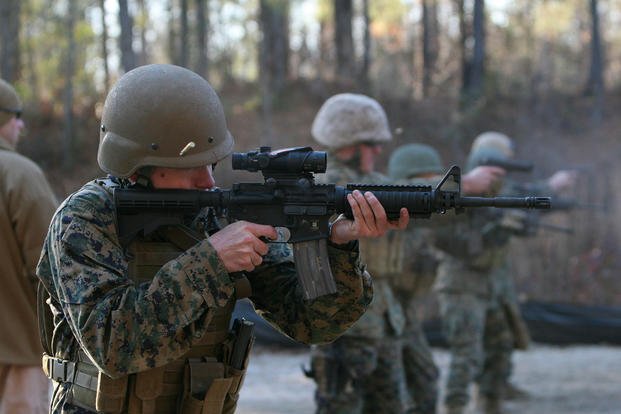There is a new Special Forces/Special Operations fitness test making its way around the team areas and creating a fun and competitive event for many of our Army, Navy, Air Force and Marine Corps special operators. It is called the upper-body round robin (UBRR) and consists of seven upper-body exercises, along with a speed and long-distance run. The UBRR provides a minimum standard for passing, which are reasonable scores as you see below, but if you want to be competitive with the best of the best, you have to push yourself far above the minimum. See events and grading scale below:
The UBRR (Upper-Body Round Robin) Events:
|
Event |
Minimum Standard |
Grading Scale for Min. Plus |
|
1 minute of push-ups |
40 |
2 points, each rep above minimum |
|
1 minute of sit-ups |
40 |
3 points, each rep above minimum |
|
Pull-ups |
6 -- not timed |
3 points, each rep above minimum |
|
Dips |
6 -- not timed |
2 points, each rep above minimum |
|
Bench press 80% bodyweight |
6 -- not timed |
3 points, each rep above minimum |
|
20-foot rope climb in body armor or weight vest -- 25 pounds |
1 |
pass/fail |
|
1 minute kip-ups |
6 |
2 points every rep above minimum |
|
4 x 25M shuttle run |
Max 24 seconds |
2 points, every tenth of a second under |
|
5-mile run or 5-mile ruck march with 45-pound dry weight |
Run -- max 40 minutes; ruck -- 75 Minutes |
2 points, every full 15 seconds from 30-35 minutes |
* Minimal rest between events < 1 minute
If you do not meet the minimum standards in every event, you will fail the entire test. The least you can score is 900 points. By adding your extra repetitions/time per exercise, you can create a team competition or have a way to grade prospective candidates seeking to enter these Special Operations teams. A good score is considered 1,300 and above, with some scorers getting about 1,500 in many of the Spec Ops units.
Common Issues and Tips for Performance
Push-ups: Regular push-ups. Do not lift your hands or feet off the floor. Once the time runs out or your knee touches the floor, the event is over.
Sit-ups: Place your hands interlocked behind your head. The up position is when your elbows touch your knees, and the down position is when your forearms touch the floor next to your head.
Pull-ups: Regular grip with palms facing away from you. Your chin must go over the bar, and your arms must be straight in the down position. These are dead hang pull-ups -- no kipping or cheating with lower body movement.
Dips: Elbows must form a 90-degree angle for each repetition to count in the down position and arm locked and straight in the up position.
Bench press: 80% of your weight for max reps. No bridging with your hips. Keep feet flat on the floor. Bar must touch your chest in the down position, and elbows must be straightened fully in the up position.
Rope climb: Climb a rope in body armor/weight vest of 25 pounds. If you do not have a rope available, try doing a rope pull-up by hanging a piece of rope over a pull-up bar and performing six rope pull-ups to simulate the rope climb.
The kip up (not a kipping pull-up): This is a grip and abdominal exercise. The individual will position himself underneath the pull-up bar as if he were doing a regular pull-up. Do a left or right facing movement so the pull-up bar is now perpendicular to the individual. Grasp the bar with palms facing each other, no more than five inches apart, arms fully extended and body hanging without touching the ground. Bring your ankles over the bar, with the bar between your ankles in the up position.
A 4 x 25-meter shuttle run can be done with blocks to pick up at the 25-meter marks. Pick up and drop blocks at each change of direction as you run four 25-meter sprints in a shuttle run method. Every tenth of a second counts.
A five-mile run under 40 minutes is not a horribly fast pace, but if you are not prepared for a five-mile run, it can be tough and potentially injurious, so build up to get five miles of running at a sub-eight-minute mile pace.
Or you can opt for the five-mile ruck with 45 pounds. Get it done in less than 75 minutes, and you are good to go.
Whether you are a future Special Operator or looking for a fun and challenging workout plan that ranks your counterparts, the UBRR is a tool to put in your backpack. Enjoy adding this to your fitness maintenance/testing program.
Stew Smith is a former Navy SEAL and fitness author certified as a Strength and Conditioning Specialist (CSCS) with the National Strength and Conditioning Association. Visit his Fitness eBook store if you're looking to start a workout program to create a healthy lifestyle. Send your fitness questions to stew@stewsmith.com.
Want to Learn More About Military Life?
Whether you're thinking of joining the military, looking for fitness and basic training tips, or keeping up with military life and benefits, Military.com has you covered. Subscribe to Military.com to have military news, updates and resources delivered directly to your inbox.



















